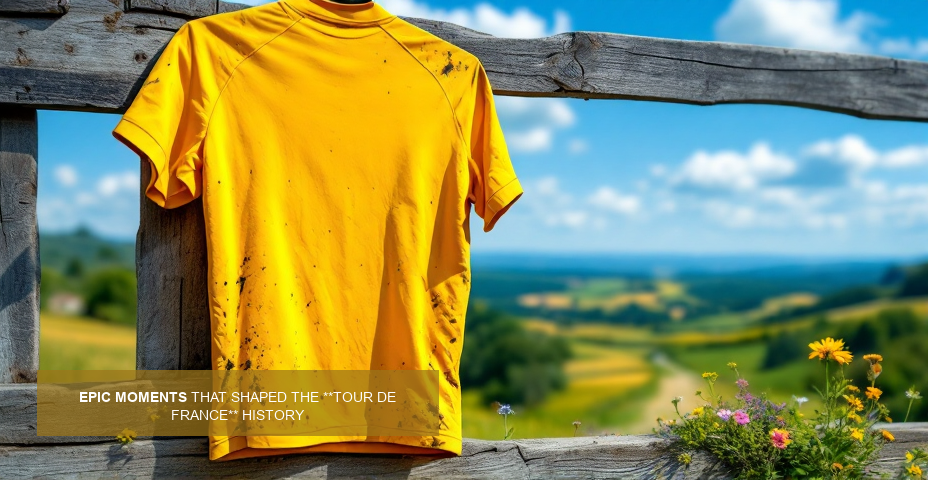The Tour de France stands as cycling's most prestigious and challenging race, captivating millions of viewers worldwide each summer. Often referred to as '21 days in July', this gruelling competition spans three weeks and covers approximately 3,500 kilometres across varied terrains including flat stages, mountain climbs, and time trials. The race is divided into 21 stages with only two rest days, making it the longest single cycling event in the professional calendar and a true test of endurance, strategy, and teamwork.
Over the past three decades, the Tour has witnessed remarkable transformations that have shaped modern cycling. From technological advancements in bicycles to changes in team tactics, the race continues to evolve while maintaining its traditions. The Tour de France history includes triumphant victories, controversial moments, and significant scandals that have altered the sport forever. These key events in the Tour de France reveal not just the evolution of cycling as a sport but also reflect broader changes in athletics, media coverage, and attitudes toward performance enhancement in professional sports.
Legendary Winners and Record Holders (1990-2023)
The Tour de France has seen many remarkable champions throughout its history. Eddy Merckx, Jacques Anquetil, Bernard Hinault, and Miguel Indurain share the record for the most Tour de France wins with five victories each. Indurain made history by winning five consecutive Tours from 1991 to 1995, displaying exceptional time-trialling abilities and steady climbing skills.
Lance Armstrong initially held seven consecutive victories (1999-2005), but these were stripped due to his admission of doping, representing one of the most significant doping scandals in cycling history. This scandal fundamentally changed how the Tour approaches anti-doping measures and altered the record books of this prestigious race.
Recent tour de france winners
The last decade has witnessed the dominance of British team Sky (later Team Ineos), with riders like Bradley Wiggins, Chris Froome, and Geraint Thomas claiming multiple victories. Froome came closest to joining the five-time winners club with four titles (2013, 2015, 2016, 2017), employing a strategy that combined strong time trials with measured mountain performances.
More recently, Tadej Pogačar and Jonas Vingegaard have emerged as the new rivalry in the 21 days in July Tour de France format. Pogačar won in 2020 and 2021, while Vingegaard claimed victory in 2022 and 2023, both demonstrating exceptional climbing abilities that proved decisive in securing their victories.
Statistical Analysis of Tour de France Victories
The modern era of the Tour has seen significant changes in race dynamics. Average speeds have increased markedly, with winners now regularly averaging over 40 km/h throughout the three-week race. Time gaps between leaders have generally decreased, reflecting the increased competitiveness and specialisation among top contenders.
Nationality trends have also shifted over the past three decades. While French riders dominated the early history of the Tour, recent decades have seen more international winners from countries including Denmark, Slovenia, Great Britain, Australia, and Colombia, demonstrating how the Tour de France has evolved into a truly global sporting event.
The Evolution of the Race Format and Route
The Tour de France spans 21 days of racing, which is why it is often referred to as "21 days in July." This format became standardized in the 1960s after decades of experimentation with race length. The three-week duration allows for a comprehensive test of endurance while incorporating rest days for recovery.
21 Days That Define Cycling Greatness
The Tour de France, cycling's premier event, spans three grueling weeks each July. From Eddy Merckx's five victories to recent champions like Tadej Pogačar, this prestigious race combines individual brilliance with team strategy across varied terrain—showcasing why it remains the ultimate test in professional cycling.
Modern Tours typically include 21 stages with two rest days strategically placed throughout the competition. This structure permits the race to cover approximately 3,500 kilometres across varied terrain while maintaining a balance between athletic challenge and human capability. The format has proven ideal for testing all aspects of cycling prowess - from time trials to mountain climbs to flat sprints.
Changes to Race Format Since 1990
Since 1990, the Tour has undergone significant format modifications to increase competition and spectator appeal. The race organisers have reduced team sizes from nine to eight riders, creating more unpredictable racing and preventing single-team dominance. Time bonuses have been adjusted repeatedly to encourage aggressive racing on flat stages.
The prologue - a short individual time trial that traditionally opened the Tour - has been phased out in many recent editions. Race planners have also experimented with team time trials, shorter mountain stages, and gravel sections to add variety and technical challenges. These changes reflect the ongoing evolution of the Tour de France race format to maintain its position as cycling's premier event.
Iconic Stages and Mountain Challenges
The Tour de France length allows for incorporation of legendary mountain passes that have defined the race's character. Alpe d'Huez with its 21 hairpin bends, Mont Ventoux with its barren moonscape summit, and Col du Tourmalet in the Pyrenees have all become synonymous with cycling greatness.
In recent decades, race organisers have introduced more varied mountain challenges, including steeper climbs like the Planche des Belles Filles (added in 2012) and high-altitude finishes above 2,000 metres. These iconic stages often determine the overall winner and have provided some of the most dramatic moments in Tour history, cementing the race's reputation for extreme challenge and spectacle.
Doping Scandals That Changed Cycling
The Tour de France has been plagued by doping controversies that have fundamentally altered cycling's reputation. The 1998 Festina Affair marked a watershed moment when customs officials discovered performance-enhancing drugs in a team car, leading to police raids, rider protests, and team withdrawals. This scandal forced cycling authorities to confront the widespread nature of doping in the professional peloton.
Other significant cases included Operation Puerto in 2006, which implicated dozens of cyclists in blood doping practices, and Floyd Landis testing positive for testosterone after winning the 2006 Tour. These incidents revealed how sophisticated doping programmes had become, with riders using EPO, blood transfusions, and other methods to gain advantages in the gruelling 21-day race.
The Armstrong Era and Aftermath
Lance Armstrong's case represents the most significant doping scandal in Tour de France history. After surviving cancer, Armstrong won an unprecedented seven consecutive Tours (1999-2005), but was later stripped of all titles when USADA's investigation revealed he had orchestrated what they called "the most sophisticated doping scheme in sports history." His confession in 2013 sent shockwaves through the cycling world.
The aftermath transformed cycling governance. Armstrong's downfall exposed systematic failures in anti-doping efforts and highlighted how team doctors, managers, and officials enabled doping practices. The scandal prompted cycling's governing bodies to implement stricter testing protocols and biological passport programmes to detect abnormal blood values over time.
Modern Anti-Doping Measures and Their Impact
Today's Tour de France operates under substantially more rigorous anti-doping protocols. The biological passport system, introduced in 2008, monitors riders' blood values over time to detect variations that may indicate doping. Out-of-competition testing has increased dramatically, with riders required to provide whereabouts information for potential random testing throughout the year.
These measures have changed racing dynamics, with performances becoming more consistent and credible. Average speeds have stabilised, and power outputs appear more realistic compared to the "superhuman" efforts of the EPO era. While doping has not been eliminated entirely, the culture of cycling has shifted toward greater transparency, with many teams now promoting clean sport as part of their identity and values.
The Modern Tour de France (2010-Present)
The past decade has witnessed remarkable technological innovation in Tour de France equipment and strategy. Carbon fibre frames have become increasingly sophisticated, with manufacturers shaving weight while maintaining structural integrity. Aerodynamic considerations now extend beyond the bicycle to include helmets, clothing, and even rider positioning.
Data analytics has transformed race tactics, with power meters and heart rate monitors providing real-time feedback to riders and team directors. Teams now analyse course profiles with unprecedented detail, tailoring equipment selection to specific stages. The introduction of electronic shifting systems has allowed for smoother gear changes, while disc brakes offer superior stopping power in wet conditions.
Media Coverage and Global Popularity
Television coverage of the Tour de France has expanded dramatically, with high-definition broadcasts reaching over 190 countries. Social media platforms have created new ways for fans to engage with the event, following favourite riders and accessing behind-the-scenes content. The Tour now attracts approximately 12 million roadside spectators annually, with millions more watching from home.
The race has also embraced digital innovation, offering mobile applications that track riders in real time and provide augmented reality experiences for viewers. This enhanced accessibility has helped grow the Tour audience beyond traditional cycling markets, particularly in Asia and North America, where interest continues to rise.
The Next Generation of Tour Champions
A new cohort of young cyclists has emerged to challenge for Tour supremacy. Riders like Tadej Pogačar and Jonas Vingegaard have demonstrated exceptional climbing ability and time-trialing prowess, suggesting the potential for multiple Tour victories. These athletes are notable for their versatility across different terrain types.
The modern Tour champion must excel in multiple disciplines while managing recovery during the gruelling three-week event. Teams now build rosters specifically designed to support their leaders through mountain stages, crosswinds, and technical descents. As training methods and equipment continue to evolve, the next generation of riders may redefine what is physically possible in professional cycling.
Summary of The Enduring Legacy of the Tour de France
The Tour de France stands as cycling's most prestigious event, evolving dramatically over three decades while maintaining its core identity. From the dominance of champions like Miguel Indurain and Chris Froome to the dark shadow of doping scandals that rocked the sport, the race has weathered significant challenges while adapting to modern demands.
Despite technological advances and route innovations, the Tour remains true to its essence as the ultimate test of cycling endurance—21 gruelling days that push athletes to their physical and mental limits. The yellow jersey continues to represent the pinnacle of cycling achievement, with the Tour maintaining its position as the most-watched annual sporting event in the world, captivating millions with its blend of athletic prowess, tactical intrigue, and spectacular French landscapes.





